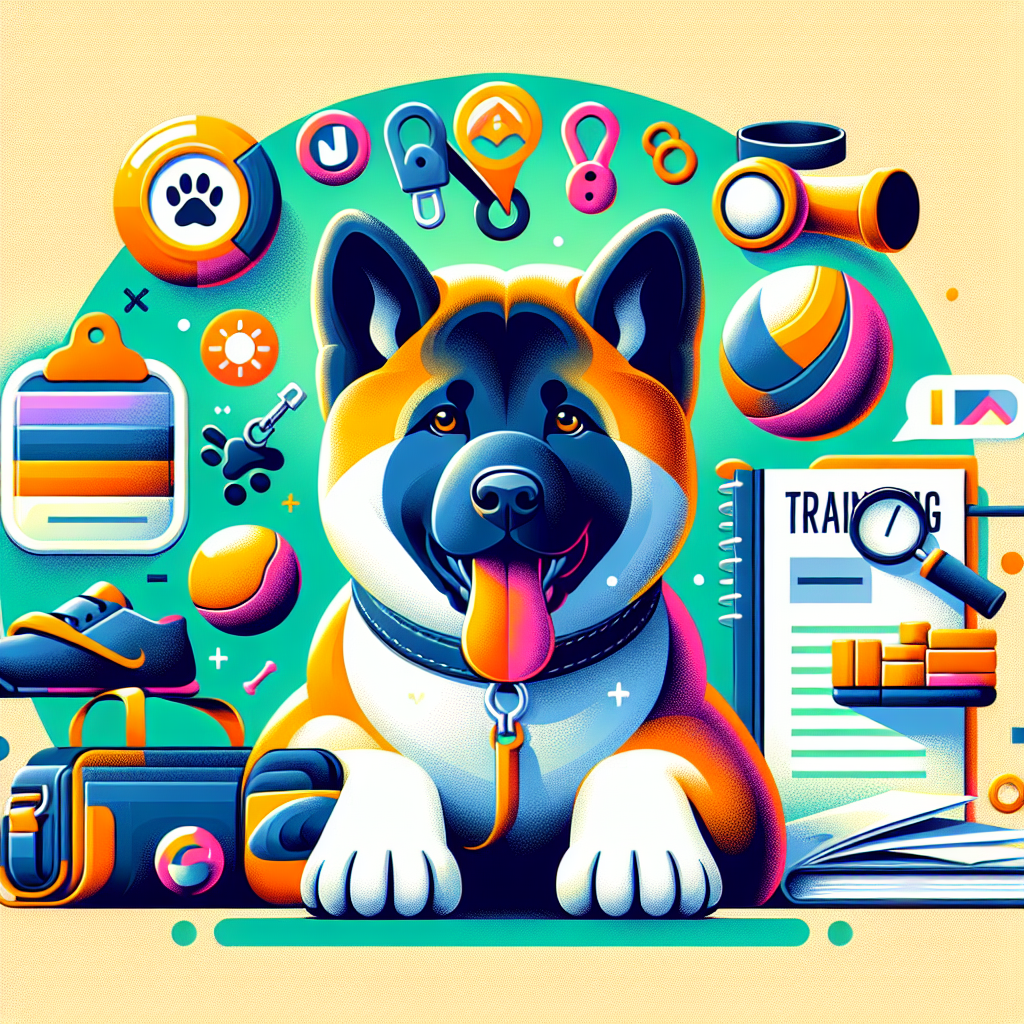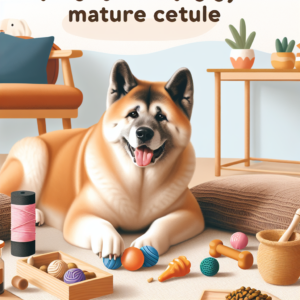Contents
- 1 Introduction
- 2 1. Understanding the Akita Breed
- 3 2. Puppy Training
- 4 3. Positive Reinforcement Training
- 5 4. Breed-Specific Training Challenges
- 6 5. Advanced Training and Tricks
- 7 6. Behavioral Issues and Corrections
- 8 7. Exercise and Mental Stimulation
- 9 8. Training Resources and Tools
- 10 9. Consistency and Patience
- 11 10. Conclusion
Introduction
Akitas are a dignified, strong-willed breed known for their loyalty and protective instincts. Their intelligence, combined with an independent nature, makes them both a rewarding and challenging breed to train. Whether you’re a new Akita owner or have experience with the breed, understanding the importance of training is crucial to fostering a well-behaved, happy companion. In this comprehensive guide, we’ll explore the training process for Akitas, covering everything from puppy basics to advanced training, common challenges, and tips for success.
1. Understanding the Akita Breed
The Akita is a large, powerful dog with a rich history. Originally bred in Japan to hunt large game, they were also used as guard dogs, which gives them an inherent protective nature. This strong-willed breed is highly loyal and independent, traits that can impact their training.
Akitas are known for their dignified demeanor, often described as aloof with strangers but deeply affectionate with their families. They require firm, consistent training, and an understanding of their unique characteristics. One of the most important factors in training an Akita is recognizing their intelligence—they are quick learners, but their independent streak can sometimes make them stubborn or selective in their responses.
Understanding the Akita’s history and temperament helps establish a foundation for training. With the right approach, these dogs can excel in obedience, agility, and even specialized roles.
2. Puppy Training
The key to training an Akita is starting early. While it’s never too late to train an Akita, beginning at a young age sets the stage for lifelong good behavior. Puppies can start learning basic commands as early as eight weeks old, but the earlier the better.
Basic commands such as sit, stay, come, and heel are crucial for Akita puppies. These are the foundational commands that will help you build a strong relationship with your dog and ensure their safety. A well-behaved Akita should respond reliably to these commands, even in the face of distractions.
Leash training is especially important for Akitas. Their size and strength mean that if they are not accustomed to walking on a leash, it can become a challenge for the owner. Introduce leash training slowly, ensuring your puppy becomes accustomed to wearing a collar or harness and walking on a lead.
Socialization is another essential component of training. Akitas tend to be reserved and sometimes aloof with strangers, so socializing your Akita puppy early on is vital. Exposing your puppy to different people, animals, environments, and experiences helps to reduce fear and aggression, laying the groundwork for a well-rounded adult dog.
3. Positive Reinforcement Training
Positive reinforcement is the most effective and humane method of training for Akitas. This breed responds well to praise, treats, and rewards, as opposed to punishment-based methods, which can damage trust and make training more difficult. Positive reinforcement builds a positive connection between you and your dog, encouraging desired behavior through reward.
For Akitas, high-value treats such as pieces of chicken, cheese, or their favorite snacks work best. Make sure to reward your dog immediately after the desired action so they can associate the reward with their behavior. Another helpful tool in positive reinforcement training is clicker training. Using a clicker, you can mark the exact moment your dog performs the correct action, making it easier for them to understand what you’re rewarding.
It’s important to maintain consistency in your training methods. Using the same commands and reward system every time will ensure your Akita knows what is expected of them.
4. Breed-Specific Training Challenges
Training an Akita can come with its own set of challenges due to their independent nature. Akitas are not typically “obedient” in the traditional sense—they have a mind of their own and are often more inclined to think critically before acting. This is especially evident when they are exposed to distractions or unfamiliar situations.
One common challenge is stubbornness. If an Akita doesn’t see the point of a particular command or action, they may resist following it. Overcoming this requires patience, consistency, and an understanding of the breed’s temperament. Akitas respond best when they see training as a form of positive interaction rather than something to endure.
Another challenge is their strong prey drive. Akitas were bred to hunt, so they can have a high instinct to chase smaller animals. Managing this behavior through controlled training sessions, leashing during walks, and reinforcing commands like “leave it” or “stay” is essential for preventing undesirable behavior.
5. Advanced Training and Tricks
Once your Akita has mastered basic obedience, you can begin introducing more advanced training. Akitas are highly intelligent and thrive on mental stimulation, so advanced training not only helps with obedience but also keeps your dog mentally sharp.
Agility training is an excellent activity for Akitas, combining physical exercise with mental challenges. Set up a basic agility course with tunnels, jumps, and weave poles to keep your dog active and engaged. The mental stimulation required for completing an agility course also strengthens your bond with your dog.
You can also teach your Akita tricks like rolling over, playing dead, or fetching specific items. Akitas love to learn when the training is fun and engaging. Make sure to use rewards and praise consistently, and break the trick down into smaller steps to help your Akita succeed.
6. Behavioral Issues and Corrections
Despite their intelligence, Akitas may develop certain behavioral issues, particularly if they’re not given enough mental stimulation or if training is inconsistent. Common behavioral problems in Akitas include excessive barking, aggression towards other animals, and possessiveness over food or toys.
To correct these behaviors, the key is consistency and patience. For excessive barking, teaching the “quiet” command and rewarding silence will help. If your Akita is aggressive toward other dogs or animals, keep them on a leash and introduce them to new dogs slowly. For possessiveness issues, it’s important to teach them boundaries and reinforce positive behaviors.
Remember to always use positive, reward-based techniques to correct undesirable behavior. Harsh training methods can lead to fear and aggression, which can make the situation worse.
7. Exercise and Mental Stimulation
Akitas are an active breed that requires both physical exercise and mental stimulation. Without adequate exercise, they can become bored and develop undesirable behaviors. On the physical side, Akitas need at least an hour of exercise every day. This can include walks, jogs, or playtime in a secure yard.
Mental stimulation is just as important as physical exercise for Akitas. This breed is highly intelligent and needs activities that challenge their minds. Puzzle toys, scent games, or obedience training sessions are great ways to keep them mentally sharp. Interactive toys that reward the dog with treats when solved are also a fun way to engage their brain.
Regular playtime not only provides exercise but also strengthens the bond between you and your Akita. Make sure to incorporate play into your daily routine, whether it’s fetch, tug-of-war, or simply running around the yard.
8. Training Resources and Tools
To aid in the training process, there are several resources and tools that can be extremely helpful for Akita owners. Books like “The Akita Handbook” and “Akita Training: The Complete Guide to Akita Training” offer in-depth knowledge on the breed and its specific needs. Online resources, such as videos on YouTube or training websites, can provide step-by-step demonstrations of various techniques.
When it comes to tools, consider using a comfortable harness or a strong leash during walks to ensure control. Crate training can also be useful for providing a safe and quiet space for your Akita when you’re not around. Clickers are highly effective in positive reinforcement training and can be found easily at pet stores or online.
If you’re struggling with training, consider hiring a reputable dog trainer with experience in Akitas. They can offer personalized advice and strategies to address specific challenges.
9. Consistency and Patience
When training an Akita, consistency and patience are your most important tools. Akitas are independent thinkers, so it may take time for them to respond to commands. However, with regular practice, positive reinforcement, and a steady routine, your Akita will learn what is expected.
Always be patient with your dog, and remember that training is a gradual process. The more consistent you are with commands and rewards, the more successful your training will be.
10. Conclusion
Training your Akita is an incredibly rewarding process. By understanding their temperament, starting early, and using positive reinforcement, you can foster a well-behaved, happy companion. Keep in mind that Akitas are intelligent and independent dogs, and their training requires patience, consistency, and commitment. With time and effort, your Akita will become a well-adjusted and obedient member of your family.


